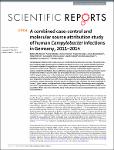A combined case-control and molecular source attribution study of human Campylobacter infections in Germany, 2011–2014
Rosner, Bettina
Schielke, Anika
Didelot, Xavier
Kops, Friederike
Breidenbach, Janina
Willrich, Niklas
Gölz, Greta
Alter, Thomas
Stingl, Kerstin
Josenhans, Christine
Suerbaum, Sebastian
Stark, Klaus
Campylobacter infection is the most commonly notified bacterial enteritis in Germany. We performed a large combined case-control and source attribution study (Nov 2011-Feb 2014) to identify risk factors for sporadic intestinal Campylobacter infections and to determine the relative importance of various animal sources for human infections in Germany. We conducted multivariable logistic regression analysis to identify risk factors. Source attribution analysis was performed using the asymmetric island model based on MLST data of human and animal/food isolates. As animal sources we considered chicken, pig, pet dog or cat, cattle, and poultry other than chicken. Consumption of chicken meat and eating out were the most important risk factors for Campylobacter infections. Additional risk factors were preparation of poultry meat in the household; preparation of uncooked food and raw meat at the same time; contact with poultry animals; and the use of gastric acid inhibitors. The mean probability of human C. jejuni isolates to originate from chickens was highest (74%), whereas pigs were a negligible source for C. jejuni infections. Human C. coli isolates were likely to originate from chickens (56%) or from pigs (32%). Efforts need to be intensified along the food chain to reduce Campylobacter load, especially on chicken meat.
No license information

